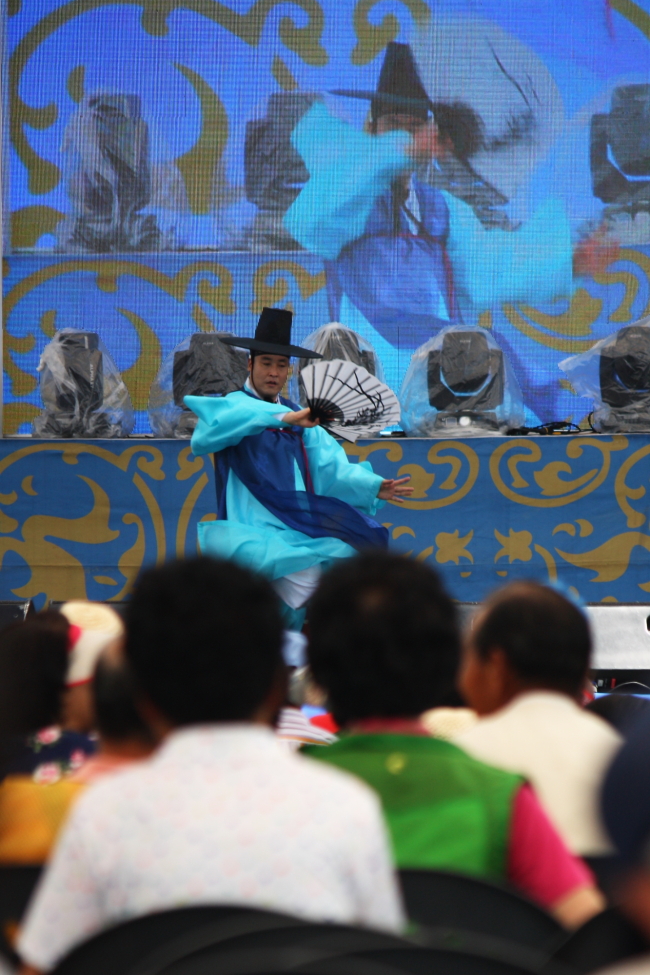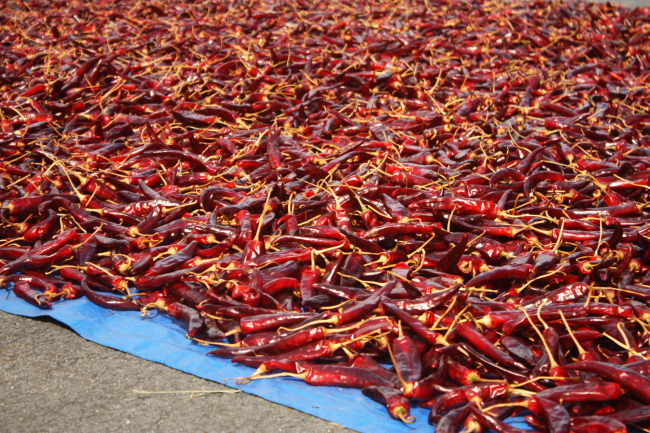Hot pepper town swept by heat wave
Cheongyang Gochu & Gugija Festival confounds expectations, offers taste of rural Korea
By Korea HeraldPublished : Sept. 5, 2014 - 19:58
Though the hot peppers of Korea may not be as famous as the habanero of Mexico or bhut jolokia of northeast India, one local variety hangs high above the rest. When served on the stem at restaurants, to be dipped in doenjang sauce, customers are warned that it’s a Cheongyang pepper. Often, these warnings come with a touch of affection and pride in these sometimes green, sometimes red firebrands, called “gochu” in Korean.
After many scorching encounters with these peppers in restaurants across the country and curious to track them to their source, I decided to visit the 15th Cheongyang Gochu and Gugija Festival, which ran from Aug. 29-31.
Though I’d visited Cheongyang, South Chungcheong Province, once before, with just enough time between buses for a quick lunch, I had failed to confirm whether the town lived up to its reputation as the epicenter of spiciness in Korea.
Situated in a heavily rural part of the country, near Mount Chilgapsan in South Chungcheong Province, the street lights and even the taxi stands were adorned with giant red representations of gochu. But when I asked around about restaurants serving spicy dishes I met with quizzical looks, and when I stepped into a diner and ordered a stew, I met with nothing too incendiary.
I imagined, though, that the town festival would feature hot pepper-eating contests and fiery local dishes. Perhaps like at Geumsan’s Ginseng Festival (running for the 34th time this year from Sept. 19-28) and Boseong’s Green Tea Festival (to be held from Sept. 26-28 for the 40th time), the local specialty would be offered up in strange new forms.
After many scorching encounters with these peppers in restaurants across the country and curious to track them to their source, I decided to visit the 15th Cheongyang Gochu and Gugija Festival, which ran from Aug. 29-31.
Though I’d visited Cheongyang, South Chungcheong Province, once before, with just enough time between buses for a quick lunch, I had failed to confirm whether the town lived up to its reputation as the epicenter of spiciness in Korea.
Situated in a heavily rural part of the country, near Mount Chilgapsan in South Chungcheong Province, the street lights and even the taxi stands were adorned with giant red representations of gochu. But when I asked around about restaurants serving spicy dishes I met with quizzical looks, and when I stepped into a diner and ordered a stew, I met with nothing too incendiary.
I imagined, though, that the town festival would feature hot pepper-eating contests and fiery local dishes. Perhaps like at Geumsan’s Ginseng Festival (running for the 34th time this year from Sept. 19-28) and Boseong’s Green Tea Festival (to be held from Sept. 26-28 for the 40th time), the local specialty would be offered up in strange new forms.

Though the festival area was easy to find, not far from the town bus stations, the local chilis proved elusive. The center of activity appeared to be the main stage; when I arrived, an emcee was bantering while senior citizens dozed in the audience section, protected from the scorching sunlight by a tent canopy. Later, pansori singers and folk musicians took the stage and siesta hour gave way to a charged fairground atmosphere.
Along the sides of the stage and in the lanes beyond were side tents with dried herbs, arts and crafts, fortune tellers and a historical dress-up booth. Soon, I found a tent of elderly women selling dried red peppers ― hefty plastic bags full, priced at 140,000 won ($138) for 10 geun (6 kilograms).
As the sunlight grew harsher, I donned a free cardboard visor and began accepting samples of local tonics, including chestnut makgeolli and gugija alcohol. Gugija, a medicinal berry that headlines the festival along with the gochu, resembles a small hot pepper but without the spice. Its various names in English include “wolfberry” and “the fruit of the Chinese matrimony vine.”
At the smaller stages were trot music entertainers, a common appearance at country markets. A far cry from the slick K-pop acts of Seoul, these included The Little Giant Art Troupe, a motley band of cross-dressing clowns and female dwarfs.
Expectantly, I ducked into one of the 20 or so dining tents and ordered a bowl of gugija bibimbap along with a jeon, a Korean pancake, containing Cheongyang gochu and gugija. Though the deep-fried peppers served on the side were tasty, the jeon failed to pack much heat.
At the point of almost having given up on Cheongyang, though, I stumbled upon the Pepper and Gugija Varieties Exhibition Hall. Above the entrance a banner proclaimed, “Agriculture is art; farming villages are the new hope.”

Half of the hall was filled with hot pepper plants from around the world (for viewing only, no picking allowed). From Papua New Guinea were thin, deep-red specimens, and from Brazil the chunky, waxy-orange amarillo pepper. Among chilis hanging like chubby red Christmas lights, and twisted red corkscrews from Bulgaria, I found Mexican habaneros and, of course, a row of Cheongyang gochu plants along the back wall.
According to an informational display on the health benefits of Cheongyang gochus, the chilis are supercharged with vitamin C, which boosts one’s energy, and capsaicin, which helps to burn fat. Also, the signage pointed out, Cheongyang hot peppers can help prevent drivers from falling asleep at the wheel and test-takers from falling asleep at their desks.
Near the door of the hall I met a quiet, smiling man named Yoo Byeong-gyu, marketing manager for the festival, who explained that Cheongyang hot peppers are hot, tasty and healthful because of the local temperature difference between night and day: “It’s a very big difference, so it makes the hot peppers the best ― more colorful and thicker. And that makes everything, especially hot peppers, grow well in this area.”
More importantly, though, he stressed, was the proximity of Mount Chilgapsan, which provides the town and its environs with pure water and fresh air.
Yoo also explained that there’s no spicy local specialty per se, aside from red pepper paste used to flavor the mountain vegetables mixed together in Chilgapsan bibimbap.
Then he ushered me over to the Spicy Flavor Experience table near the door, to sample ground Cheongyang gochu and compare it with its greatest rivals. It has an intensity of just 10,000 Scoville heat units, Yoo pointed out, compared to 300,000 SHU for the habanero and 1 million for the bhut jolokia. But with my mouth burning up from a cup of the local gochu alcohol, the taste of the world peppers blended into a single, universal sting.
Getting there
Buses to Cheongyang leave six times a day from Gangnam Express Bus Terminal in Seoul (tickets cost 10,100 won; the trip takes about 2 1/2 hours). Several buses also depart each day from Nambu Bus Terminal and Dong Seoul Terminal.
By Matthew C. Crawford (mattcrawford@heraldcorp.com)
-
Articles by Korea Herald



![[Exclusive] Korean military set to ban iPhones over 'security' concerns](http://res.heraldm.com/phpwas/restmb_idxmake.php?idx=644&simg=/content/image/2024/04/23/20240423050599_0.jpg&u=20240423183955)
![[AtoZ into Korean mind] Humor in Korea: Navigating the line between what's funny and not](http://res.heraldm.com/phpwas/restmb_idxmake.php?idx=644&simg=/content/image/2024/04/22/20240422050642_0.jpg&u=)




![[Graphic News] 77% of young Koreans still financially dependent](http://res.heraldm.com/phpwas/restmb_idxmake.php?idx=644&simg=/content/image/2024/04/22/20240422050762_0.gif&u=)
![[Herald Interview] Why Toss invited hackers to penetrate its system](http://res.heraldm.com/phpwas/restmb_idxmake.php?idx=644&simg=/content/image/2024/04/22/20240422050569_0.jpg&u=20240422150649)





![[Exclusive] Korean military to ban iPhones over security issues](http://res.heraldm.com/phpwas/restmb_idxmake.php?idx=652&simg=/content/image/2024/04/23/20240423050599_0.jpg&u=20240423183955)



![[Today’s K-pop] Ateez confirms US tour details](http://res.heraldm.com/phpwas/restmb_idxmake.php?idx=642&simg=/content/image/2024/04/23/20240423050700_0.jpg&u=)